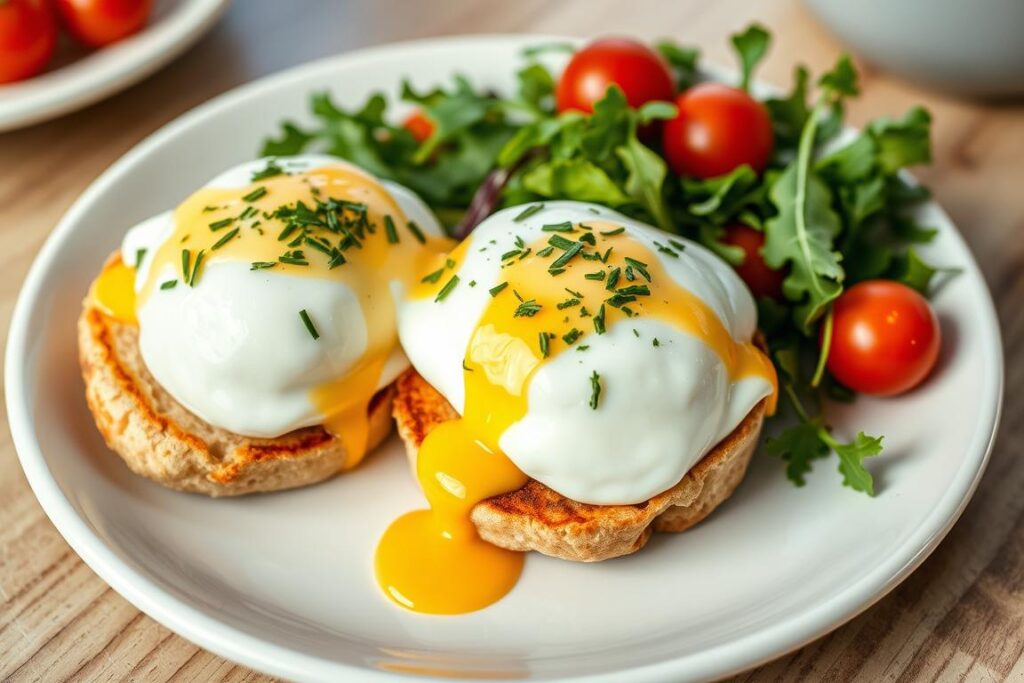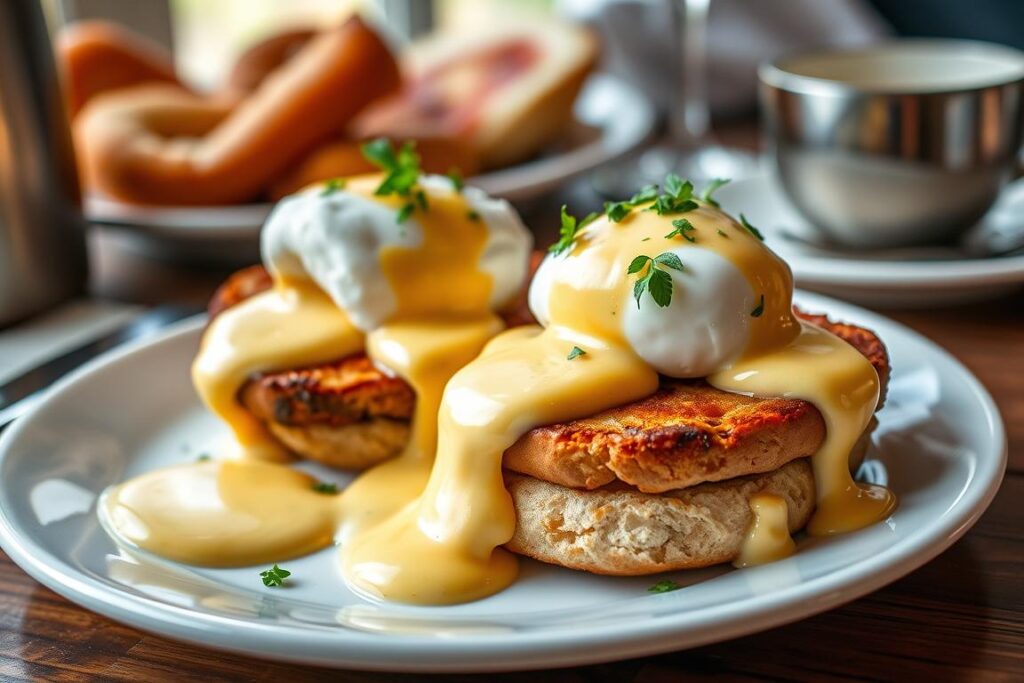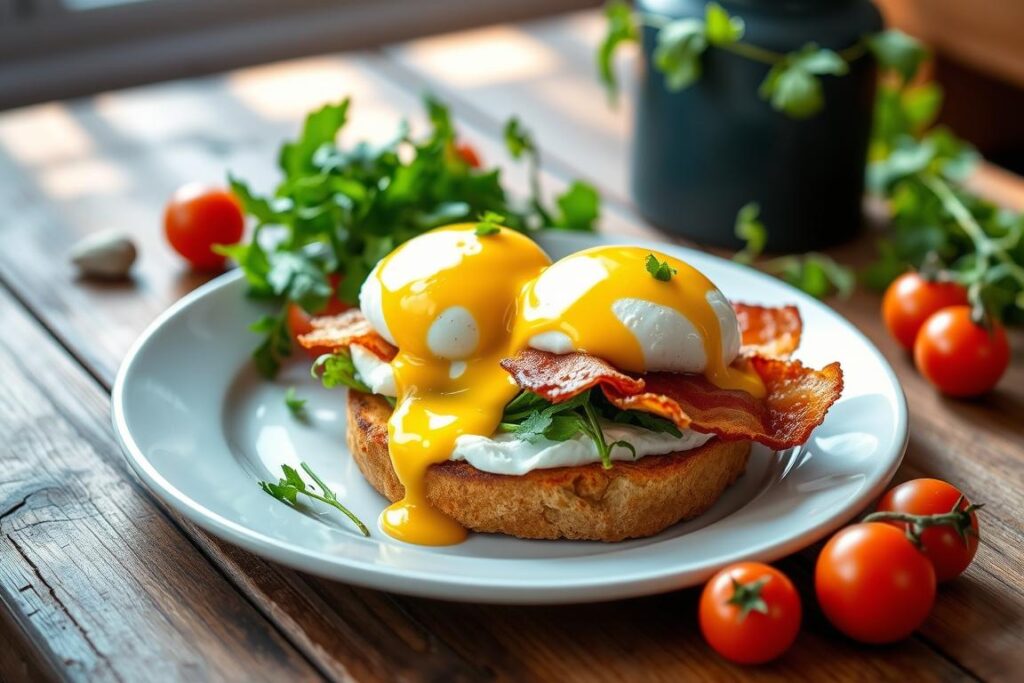Imagine a weekend morning filled with the scent of butter and the soft sound of a poaching egg. The smell of crispy bacon adds to the magic. That’s when you know Egg Benedict is more than food. It’s a mix of flavors and textures.
You’re ready to learn how to make Egg Benedict. It’s not about being a fancy chef. It’s about paying attention to the little things. A perfectly poached egg, creamy hollandaise, and a golden English muffin make your breakfast special.
Let’s explore the art and science of this classic dish. We’ll show you how to make it perfect. This will turn your morning into a feast for your taste buds.

Table of Contents
The Mysterious Origins of Eggs Benedict
The story of Eggs Benedict is as rich as the dish itself. It combines velvety hollandaise sauce, soft poached eggs, and crisp Canadian bacon. But, its true beginnings are a mystery, with many stories and figures claiming to have started it.

Debunking the Myth: Delmonico’s Restaurant and Socialite LeGrand Benedict
In the late 19th century, New York City’s high society loved Egg Benedict. One story says socialite LeGrand Benedict asked for a special dish at Delmonico’s Restaurant. She worked with the chef to create what we now know as Egg Benedict.
The Tale of Lemuel Benedict: A Cure for Overindulgence
Lemuel Benedict, a Wall Street broker, once ordered a unique dish at the Waldorf Hotel. He wanted something to cure his hangover. The chef turned his order into the elegant dish we know today.
Eggs Benedict has become a favorite brunch dish worldwide. Its history, whether from a socialite or a reveler, makes it even more special. Each ingredient and technique in the recipe adds to its charm and popularity.
Choosing High-Quality Ingredients for the Best Eggs Benedict
For the best Egg Benedict, picking top-notch ingredients is key. Each part, from fresh eggs to Canadian bacon, is vital. They work together to make a dish that’s rich yet perfectly balanced. Let’s explore how choosing the best ingredients can make your Eggs Benedict unforgettable.
Selecting the Freshest Eggs
Fresh eggs are the heart of Eggs Benedict. Studies show that free-range eggs make the dish taste better. The eggs’ freshness is also important for poaching. It affects the dish’s look and feel.
Choose eggs that are fresh and of high quality. This ensures a smooth, velvety poached egg every time.
Canadian Bacon Vs. Regular Bacon: What to Use
Canadian bacon is the traditional choice for Eggs Benedict. It’s leaner and sweeter than regular bacon. This makes it a perfect match for the creamy hollandaise sauce and soft eggs.
This meat adds a delicious savory flavor. It keeps the dish true to its original recipe.
The Importance of Fresh English Muffins and Unsalted Butter
The base of Eggs Benedict is the English muffins. Choose artisanal ones for better texture and flavor absorption. Unsalted butter is also key for the hollandaise sauce. It lets you control the seasoning and avoid a salty sauce.

| Component | Caloric Content | Percentage of Total |
|---|---|---|
| English Muffin | 200 calories | 31.25% |
| Canadian Bacon | 140 calories | 21.88% |
| Poached Egg and Hollandaise | 300 calories | 46.87% |
| Total | 640 calories | 100% |
Using high-quality ingredients like fresh eggs and Canadian bacon makes a tastier meal. It also boosts customer satisfaction. By choosing better ingredients, you’re not just cooking. You’re creating a memorable experience.
Mastering the Art of the Perfect Poached Egg
Perfect poached eggs are key to a great Eggs Benedict. It might seem hard, but with the right steps, you can get it right. This skill makes simple dishes into fancy brunches.
The Traditional Vinegar Water Vortex Method
The vinegar water vortex method is a classic way to poach eggs. It uses vinegar in boiling water to make the egg whites wrap around the yolk. This creates a neat egg with a creamy center.
This method works well because vinegar helps the egg whites set faster. This keeps the egg’s shape while it cooks.
Innovative Poaching Techniques: Sous Vide and Microwave
The sous vide method is modern and precise. It cooks eggs in a water bath at a set temperature. This ensures perfect doneness every time.
For a quick option, try microwaving eggs. Just use vinegar water, crack in an egg, and cover it. Cook for 30 seconds to a minute for a ready-to-eat egg.

Here’s a table comparing these poaching methods. It shows time, ease, and egg quality:
| Method | Time | Convenience | Quality of Poached Eggs |
|---|---|---|---|
| Vinegar Water Vortex | About 3-4 minutes | Requires attention to timing and water temperature | Smooth, even whites with creamy yolks |
| Sous Vide | 13-15 minutes (including water heat-up) | Set and forget; minimal monitoring needed | Consistently perfect texture and doneness |
| Microwave | 1-2 minutes | Fast and convenient with minimal cleanup | Suitable quality, though sometimes less uniform than other methods |
Mastering poached eggs makes your breakfast look and taste better. Whether you choose the classic vinegar method or something new like sous vide or microwave, each way has its own perks. It’s all about finding what works best for you.
The Secret to Golden, Toasty English Muffins
Looking for the best Eggs Benedict recipe? Start with golden English muffins. They’re key for layering and add a special texture. Toasting them to golden brown is key for a crunchy yet absorbent base.
Lightly butter your English muffins before toasting. This step boosts their flavor and helps them turn golden. Here’s how to toast them perfectly, making your Eggs Benedict a hit:
- Preheat your oven or toaster to a medium-high setting.
- Spread a thin layer of unsalted butter on each half of the muffin. For an even more indulgent twist, consider using clarified butter which lends a richer, more decadent flavor.
- Place the muffins on a baking sheet, buttered side up, and toast for about 3-4 minutes or until they are golden brown.
- Keep an eye on them to make sure they don’t burn—golden English muffins should be warm and crispy but not overly hard or charred.
Golden English muffins are more than just a base. They support the poached eggs, Canadian bacon, and hollandaise sauce. Their crisp texture balances the dish’s richness.
Here’s a quick glance at the optimal muffin preparation for serving 4 individuals:
| Ingredient | Amount | Purpose |
|---|---|---|
| English muffins | 2, halved | Base for layering |
| Unsalted butter | 4 teaspoons | For toasting muffins |
| Prep time | 5 minutes | Efficient kitchen time management |
| Toasting time | 3-4 minutes | Achieve golden crispness without burning |
Golden English muffins are the secret to a great Eggs Benedict. They set the stage for a memorable brunch. Every bite will be a delight.
Achieving the Perfect Sear on Canadian Bacon
When making the best Eggs Benedict, searing Canadian bacon is essential. It adds a crispy yet tender texture and boosts the flavor.
Why Searing Matters for Flavor and Texture
Searing Canadian bacon creates a caramelized crust. This crust is key to the dish’s flavor. It also adds a satisfying crunch that contrasts with the soft egg and smooth Hollandaise sauce.
It brings out the bacon’s umami flavor and a buttery texture. This texture melts in your mouth, making every bite enjoyable.
The Best Methods for Searing Canadian Bacon
To get the perfect sear, use medium-high heat and a non-stick skillet. Let the Canadian bacon cook undisturbed until it’s crispy. This method ensures it’s cooked just right, adding a rich texture and flavor to your Eggs Benedict.
| Method | Description | Advantages |
|---|---|---|
| Pan-Searing | Quickly sear in a hot skillet without oil | Creates a consistent, caramelized exterior. |
| Grilling | Place on a grill over medium heat | Imparts a smoky flavor, enriching the taste. |
| Oven-Broiling | Broil under high heat for a short period | Even cooking, ideal for large batches. |
By mastering the art of searing Canadian bacon, you’ll make your Eggs Benedict unforgettable. Whether it’s for a special brunch or a casual breakfast, these methods will make every bite a delight. It’s sure to become a favorite brunch dish.
Decoding the Hollandaise Sauce
The Hollandaise sauce recipe is key to making Eggs Benedict. It’s simpler than it looks. Each part plays a role in creating the perfect sauce.
The Basics: Egg Yolks, Butter, and Lemon Juice
Egg yolks, melted butter, and lemon juice make up the sauce. The trick is to mix them right. This makes the sauce creamy and tangy, boosting Eggs Benedict’s flavors.
Maintaining the Perfect Sauce Texture
To keep the Hollandaise sauce smooth, whisk it constantly while heating. This prevents it from curdling. It makes your Eggs Benedict extra special.
| Ingredient | Role | Tips for Optimal Texture |
|---|---|---|
| Egg Yolks | Emulsifier | Keep yolks at room temperature and whisk steadily |
| Melted Butter | Base | Use unsalted butter for a smooth, creamy texture |
| Lemon Juice | Flavor Enhancer | Add gradually to taste, balancing the tanginess |
Maintaining Temperatures for Serving Eggs Benedict
To serve Eggs Benedict, you need to get the temperatures right for each part. This means keeping the poached eggs and hollandaise sauce at their best. Let’s look at how to keep these elements warm.
Keeping Poached Eggs and Hollandaise Sauce Warm
After cooking your poached eggs, you must keep them warm. Place them in warm water that’s not too hot. This way, they stay safe and tasty. For the hollandaise sauce, make it just before serving to keep it fresh.
A double boiler on low heat is great for the sauce. It keeps the sauce warm without letting it curdle.
Timing Your Preparation for Optimal Temperature
Timing is key when making Eggs Benedict. Start with the hollandaise sauce because it can stay warm for a bit. Once it’s ready, poach the eggs.
This way, both parts are ready at the same time. They’ll offer the perfect mix of flavors and temperatures.
By using these methods, your Eggs Benedict will be delicious and served just right. It will make for a breakfast you’ll remember.
Layered Seasoning: Elevating Eggs Benedict
Eggs Benedict is more than just a breakfast dish. It’s a masterpiece of flavors, thanks to its layered seasoning. This classic dish combines simplicity with complex tastes, making it a favorite for many.
Each part of Eggs Benedict adds something special. The poached eggs are soft and creamy, with just a touch of pepper. They pair well with the crispy Canadian bacon. The toasted English muffin adds a crunchy texture and a hint of earthiness.
But the real star is the hollandaise sauce. It’s rich, lemony, and ties all the flavors together. Its bright, tangy taste makes the dish complete.
What makes Eggs Benedict stand out are the subtle seasonings. A little cayenne or paprika can make the hollandaise bold. Fresh herbs like dill or chervil add a fresh touch without overpowering the dish.
Getting the flavors right is key to making great Eggs Benedict. Adding avocado or crabmeat can change the dish, but it’s important to keep the core flavors in mind. This way, you can enjoy a new twist without losing the essence of the dish.
Trying different Eggs Benedict variations is fun and exciting. It lets you mix traditional methods with new ideas. This way, you can create a dish that honors its roots while also surprising your taste buds.
Constructing the Perfect Eggs Benedict Plate
Learning to make Eggs Benedict is key to improving your breakfast menu. This dish is more than just a meal; it’s a work of art. Each layer is important for both taste and look.
Order of Assembly: From Muffin to Hollandaise
The first step is a toasted English muffin, warm and buttered. Then, a slice of Canadian bacon goes on top. After that, a poached egg is added, with a runny yolk.
The hollandaise sauce is the last touch. It’s made with egg yolks, lemon juice, and butter. This sauce adds a creamy, rich flavor.
The Role of Each Component in Final Presentation
The look of Eggs Benedict is just as important as its taste. Each part adds its own color and texture. The hollandaise sauce adds a golden touch.
The white of the egg and the pink of the bacon contrast beautifully. A sprinkle of chives or cayenne can add color and flavor. This makes the dish even more appealing.
Getting the taste and look right takes practice. But with these tips, you can make Eggs Benedict that’s both stunning and delicious.
Exploring Eggs Benedict Variations
The classic Eggs Benedict is a brunch favorite. But, new twists have made it even more exciting. Try the creamy avocado or the fresh spinach versions for a change.
Avocado or Spinach: A Twist on the Classic
Avocado Eggs Benedict adds a rich, buttery taste. It’s a hit with those who love modern flavors. Spinach Eggs Benedict, or Eggs Benedict Florentine, swaps bacon for spinach. It’s healthier and looks great.
Alternative Hollandaise Sauces: Adding Spice and Herbs
Chefs are now making hollandaise sauce with spicy Cajun and herbs. This turns the dish into a fun adventure. It’s not just about taste; it’s also about looks.
Trying these Eggs Benedict variations is like discovering new flavors. Avocado, spinach, and special hollandaise sauces make every bite exciting. You’ll always find something new to enjoy.
Eggs Benedict: The Quintessential Brunch Dish
Exploring brunch menu ideas often leads to Eggs Benedict. This dish has been a classic brunch dish for over a century. It’s a mix of rich flavors and satisfying ingredients, making it the ultimate brunch treat.
At first glance, Eggs Benedict seems simple. It’s made of poached eggs, Canadian bacon, and English muffins with hollandaise sauce. But each part is key to its perfect taste. The dish starts with a buttery English muffin, topped with smooth eggs and salty bacon. It’s all covered in a creamy sauce with a hint of lemon.
In recent years, Eggs Benedict has become even more popular. It’s now seen with modern twists, like avocado. Here’s a look at why this dish is a brunch favorite:
| Statistic | Data |
|---|---|
| US Brunch-goers Who Consider Eggs Benedict Essential | 63% |
| Average Price in Restaurants | $10 – $15 |
| Ingredient Cost per Serving | Approximately $1.20 |
| Presence on Brunch Menus in Last 5 Years | Increased from 30% to over 45% |
| Preference for Classic Eggs Benedict | 76% |
Restaurants like Superfine Playa and Ryla show Eggs Benedict’s lasting charm. It can stay true to its roots or try new flavors. Either way, it remains a sophisticated yet comforting brunch choice.
Conclusion
Mastering the Perfect Eggs Benedict is all about the details. From poached eggs to hollandaise sauce, every step matters. It’s not just about cooking; it’s about creating a masterpiece.
The dish’s beauty lies in its layers. Warm English muffins, rich hollandaise, and fresh eggs come together. This makes Eggs Benedict a standout at brunch.
But there’s more to Eggs Benedict than the classic recipe. You can add crab meat for a fancy twist or use special ingredients for guests with dietary needs. This makes it perfect for any occasion, big or small.
Whether you’re making a big batch or individual servings, the key is balance. Add your own touch to make it special. This way, you ensure everyone enjoys their meal.
When cooking Eggs Benedict, remember the little things. A bit of lemon, vinegar, and crab meat add to the flavor. Poach eggs for 3-4 minutes and make hollandaise smooth. Season with salt and pepper to taste.
Eggs Benedict is more than a dish; it’s a reflection of your cooking skills. With practice and patience, you’ll create a dish that impresses everyone. Serve it with pride and enjoy the smiles it brings. Looking for more delicious morning meals? Explore our collection of breakfast recipes for more inspiration.
FAQ
What are the key components of Eggs Benedict?
Eggs Benedict is a classic brunch dish. It has an English muffin, Canadian bacon, poached eggs, and hollandaise sauce. Each part is important for a delicious breakfast.
Where did Eggs Benedict originate?
The story of Eggs Benedict’s start is a bit mixed. Some say it was at Delmonico’s Restaurant in New York City, inspired by LeGrand Benedict. Others believe it was Lemuel Benedict’s idea at the Waldorf Hotel, as a hangover cure.
How can I make the best Eggs Benedict?
For the best Eggs Benedict, use top-notch ingredients. Choose fresh eggs, Canadian bacon, English muffins, and unsalted butter. Focus on poaching eggs and making hollandaise sauce right.
How do I poach eggs perfectly for Eggs Benedict?
To poach eggs well, use vinegar water and a vortex method. This helps the egg whites wrap around the yolk. You can also try sous vide or microwave for even results.
What is the secret to toasty golden English muffins for Eggs Benedict?
Toast the English muffins until they’re golden. This adds a nice crunch and helps them soak up the hollandaise sauce without getting soggy.
Why should Canadian bacon be seared for Eggs Benedict?
Seared Canadian bacon gets caramelized, making it sweeter and savory. It adds a crispy texture that goes well with the other ingredients.
What are the tips for making a smooth hollandaise sauce?
For smooth hollandaise, whisk egg yolks, melted butter, and lemon juice gently over low heat. This prevents it from curdling and keeps it creamy.
How do I keep the components of Eggs Benedict warm when serving?
To keep eggs and sauce warm, prepare them just before serving. Use a warm water bath or low heat to keep them at the right temperature.
What role does seasoning play in Eggs Benedict?
Seasoning is key in Eggs Benedict. From peppering the eggs to adding lemon zest to the sauce, it enhances the flavor in every bite.
In what order should I assemble Eggs Benedict?
Start with a warm English muffin, then add Canadian bacon, a poached egg, and finish with hollandaise sauce. This order ensures the best taste and presentation.
What are some popular Eggs Benedict variations?
You can add avocado for creaminess or spinach for a different taste. Try unique hollandaise sauce flavors, like adding spices or herbs, for a twist.
Why is Eggs Benedict considered the quintessential brunch dish?
Eggs Benedict is loved for its soft eggs, rich sauce, and crispy bacon. It offers a luxurious dining experience that makes it a brunch favorite.
What are the key components of Eggs Benedict?
Eggs Benedict is a classic brunch dish. It has an English muffin, Canadian bacon, poached eggs, and hollandaise sauce. Each part is important for a delicious breakfast.
Where did Eggs Benedict originate?
The story of Eggs Benedict’s start is a bit mixed. Some say it was at Delmonico’s Restaurant in New York City, inspired by LeGrand Benedict. Others believe it was Lemuel Benedict’s idea at the Waldorf Hotel, as a hangover cure.
How can I make the best Eggs Benedict?
For the best Eggs Benedict, use top-notch ingredients. Choose fresh eggs, Canadian bacon, English muffins, and unsalted butter. Focus on poaching eggs and making hollandaise sauce right.
How do I poach eggs perfectly for Eggs Benedict?
To poach eggs well, use vinegar water and a vortex method. This helps the egg whites wrap around the yolk. You can also try sous vide or microwave for even results.
What is the secret to toasty golden English muffins for Eggs Benedict?
Toast the English muffins until they’re golden. This adds a nice crunch and helps them soak up the hollandaise sauce without getting soggy.
Why should Canadian bacon be seared for Eggs Benedict?
Seared Canadian bacon gets caramelized, making it sweeter and savory. It adds a crispy texture that goes well with the other ingredients.
